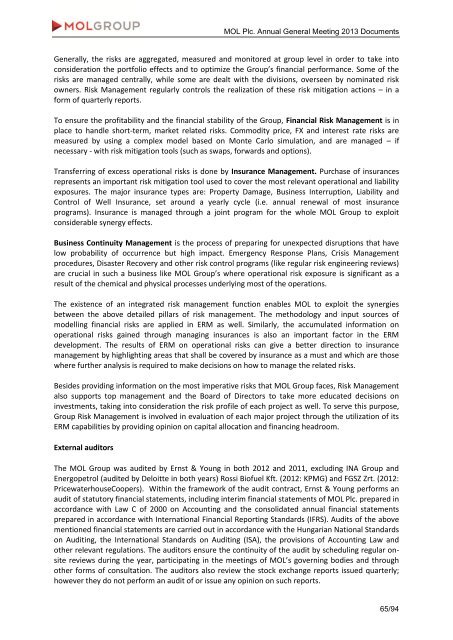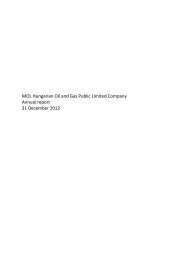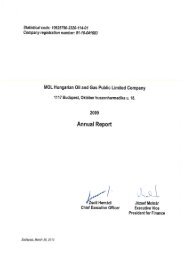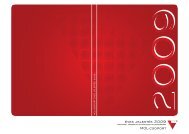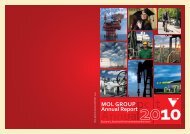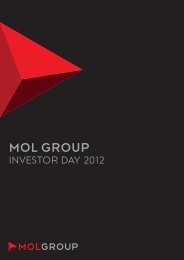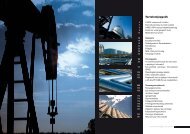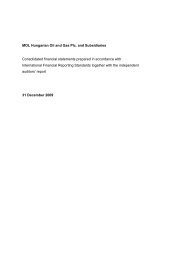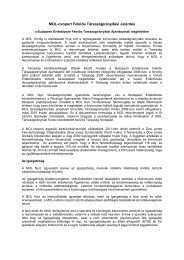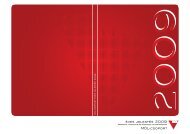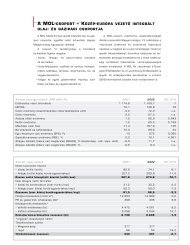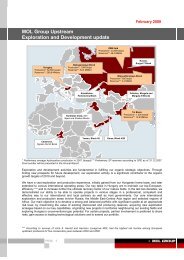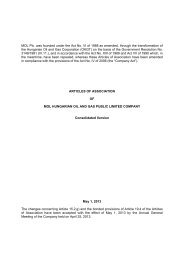DOCUMENTS FOR THE ANNUAL GENERAL MEETING
DOCUMENTS FOR THE ANNUAL GENERAL MEETING
DOCUMENTS FOR THE ANNUAL GENERAL MEETING
You also want an ePaper? Increase the reach of your titles
YUMPU automatically turns print PDFs into web optimized ePapers that Google loves.
MOL Plc. Annual General Meeting 2013 Documents<br />
Generally, the risks are aggregated, measured and monitored at group level in order to take into<br />
consideration the portfolio effects and to optimize the Group’s financial performance. Some of the<br />
risks are managed centrally, while some are dealt with the divisions, overseen by nominated risk<br />
owners. Risk Management regularly controls the realization of these risk mitigation actions – in a<br />
form of quarterly reports.<br />
To ensure the profitability and the financial stability of the Group, Financial Risk Management is in<br />
place to handle short-term, market related risks. Commodity price, FX and interest rate risks are<br />
measured by using a complex model based on Monte Carlo simulation, and are managed – if<br />
necessary - with risk mitigation tools (such as swaps, forwards and options).<br />
Transferring of excess operational risks is done by Insurance Management. Purchase of insurances<br />
represents an important risk mitigation tool used to cover the most relevant operational and liability<br />
exposures. The major insurance types are: Property Damage, Business Interruption, Liability and<br />
Control of Well Insurance, set around a yearly cycle (i.e. annual renewal of most insurance<br />
programs). Insurance is managed through a joint program for the whole MOL Group to exploit<br />
considerable synergy effects.<br />
Business Continuity Management is the process of preparing for unexpected disruptions that have<br />
low probability of occurrence but high impact. Emergency Response Plans, Crisis Management<br />
procedures, Disaster Recovery and other risk control programs (like regular risk engineering reviews)<br />
are crucial in such a business like MOL Group’s where operational risk exposure is significant as a<br />
result of the chemical and physical processes underlying most of the operations.<br />
The existence of an integrated risk management function enables MOL to exploit the synergies<br />
between the above detailed pillars of risk management. The methodology and input sources of<br />
modelling financial risks are applied in ERM as well. Similarly, the accumulated information on<br />
operational risks gained through managing insurances is also an important factor in the ERM<br />
development. The results of ERM on operational risks can give a better direction to insurance<br />
management by highlighting areas that shall be covered by insurance as a must and which are those<br />
where further analysis is required to make decisions on how to manage the related risks.<br />
Besides providing information on the most imperative risks that MOL Group faces, Risk Management<br />
also supports top management and the Board of Directors to take more educated decisions on<br />
investments, taking into consideration the risk profile of each project as well. To serve this purpose,<br />
Group Risk Management is involved in evaluation of each major project through the utilization of its<br />
ERM capabilities by providing opinion on capital allocation and financing headroom.<br />
External auditors<br />
The MOL Group was audited by Ernst & Young in both 2012 and 2011, excluding INA Group and<br />
Energopetrol (audited by Deloitte in both years) Rossi Biofuel Kft. (2012: KPMG) and FGSZ Zrt. (2012:<br />
PricewaterhouseCoopers). Within the framework of the audit contract, Ernst & Young performs an<br />
audit of statutory financial statements, including interim financial statements of MOL Plc. prepared in<br />
accordance with Law C of 2000 on Accounting and the consolidated annual financial statements<br />
prepared in accordance with International Financial Reporting Standards (IFRS). Audits of the above<br />
mentioned financial statements are carried out in accordance with the Hungarian National Standards<br />
on Auditing, the International Standards on Auditing (ISA), the provisions of Accounting Law and<br />
other relevant regulations. The auditors ensure the continuity of the audit by scheduling regular onsite<br />
reviews during the year, participating in the meetings of MOL’s governing bodies and through<br />
other forms of consultation. The auditors also review the stock exchange reports issued quarterly;<br />
however they do not perform an audit of or issue any opinion on such reports.<br />
65/94


